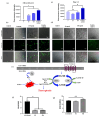CD44 Receptor-Mediated Ferroptosis Induction by Hyaluronic Acid Carbon Quantum Dots in Triple-Negative Breast Cancer Cells Through Downregulation of SLC7A11 Pathway
- PMID: 40363642
- PMCID: PMC12073876
- DOI: 10.3390/ma18092139
CD44 Receptor-Mediated Ferroptosis Induction by Hyaluronic Acid Carbon Quantum Dots in Triple-Negative Breast Cancer Cells Through Downregulation of SLC7A11 Pathway
Abstract
The field of cancer therapy is actively pursuing highly effective self-targeted drug delivery materials endowed with exceptional properties. Recently, hyaluronic acid (HA), a naturally occurring polysaccharide, has been recognized as a potential target ligand for CD44 receptors, which are frequently expressed on various solid tumor cells targeted in cancer therapy. HA carbon quantum dots (CQDs) exhibit several advantageous properties, including a high surface area-to-volume ratio, small particle size, biocompatibility, and low cytotoxicity, making them ideal for biomedical applications, such as CD44-targeted drug delivery in ferroptosis-based cancer therapy. In this study, we synthesized HA-CQDs to enhance CD44-mediated ligand-receptor interactions targeting triple-negative breast cancer (TNBC). CQDs facilitate the intracellular generation of reactive oxygen species (ROS), leading to glutathione depletion. These processes result in crucial actions such as the downregulation of glutathione peroxidase 4, downregulation of solute carrier family 7 member 11, and inhibition of cystine intake. The subsequent intracellular ROS, originating from lipid peroxidation, induces ferroptosis. Our HA-CQDs engage CD44 receptors, selectively targeting TNBCs and enhancing cancer recognition. This interaction potentially enhances the nanoplatform-based CD44 targeted therapeutic effects in inducing ferroptosis.
Keywords: carbon quantum dots (CQDs); ferroptosis; glutathione depletion; hyaluronic acid (HA); lipid peroxidation; reactive oxygen species (ROS).
Conflict of interest statement
The authors declare no conflicts of interest.
Figures








Similar articles
-
Novel Carbon Quantum Dots Precisely Trigger Ferroptosis in Cancer Cells through Antioxidant Inhibition Synergistic Nanocatalytic Activity.ACS Appl Mater Interfaces. 2024 Jul 24;16(29):37456-37467. doi: 10.1021/acsami.4c04307. Epub 2024 Jul 15. ACS Appl Mater Interfaces. 2024. PMID: 39007694
-
A dual-targeted hyaluronic acid-gold nanorod platform with triple-stimuli responsiveness for photodynamic/photothermal therapy of breast cancer.Acta Biomater. 2019 Jan 1;83:400-413. doi: 10.1016/j.actbio.2018.11.026. Epub 2018 Nov 19. Acta Biomater. 2019. PMID: 30465921
-
DON encapsulated carbon dot-vesicle conjugate in therapeutic intervention of lung adenocarcinoma by dual targeting of CD44 and SLC1A5.Nanoscale. 2024 Dec 5;16(47):21817-21836. doi: 10.1039/d4nr00426d. Nanoscale. 2024. PMID: 39513401
-
Ferroptosis as a promising targeted therapy for triple negative breast cancer.Breast Cancer Res Treat. 2024 Oct;207(3):497-513. doi: 10.1007/s10549-024-07387-7. Epub 2024 Jun 14. Breast Cancer Res Treat. 2024. PMID: 38874688 Review.
-
Lipid Peroxidation and Iron Metabolism: Two Corner Stones in the Homeostasis Control of Ferroptosis.Int J Mol Sci. 2022 Dec 27;24(1):449. doi: 10.3390/ijms24010449. Int J Mol Sci. 2022. PMID: 36613888 Free PMC article. Review.
References
Grants and funding
LinkOut - more resources
Full Text Sources
Miscellaneous

